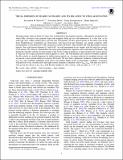| dc.contributor.author | Irwin, Jonathan | |
| dc.contributor.author | Charbonneau, David | |
| dc.contributor.author | Berlind, Perry | |
| dc.contributor.author | Calkins, Michael L. | |
| dc.contributor.author | Mink, Jessica | |
| dc.contributor.author | Newton, Elisabeth R | |
| dc.date.accessioned | 2017-06-08T13:59:53Z | |
| dc.date.available | 2017-06-08T13:59:53Z | |
| dc.date.issued | 2017-01 | |
| dc.date.submitted | 2016-10 | |
| dc.identifier.issn | 1538-4357 | |
| dc.identifier.uri | http://hdl.handle.net/1721.1/109733 | |
| dc.description.abstract | The high-energy emission from low-mass stars is mediated by the magnetic dynamo. Although the mechanisms by which fully convective stars generate large-scale magnetic fields are not well understood, it is clear that, as for solar-type stars, stellar rotation plays a pivotal role. We present 270 new optical spectra of low-mass stars in the Solar Neighborhood. Combining our observations with those from the literature, our sample comprises 2202 measurements or non-detections of Hα emission in nearby M dwarfs. This includes 466 with photometric rotation periods. Stars with masses between 0.1 and 0.6 M[subscript ⊙] are well-represented in our sample, with fast and slow rotators of all masses. We observe a threshold in the mass–period plane that separates active and inactive M dwarfs. The threshold coincides with the fast-period edge of the slowly rotating population, at approximately the rotation period at which an era of rapid rotational evolution appears to cease. The well-defined active/inactive boundary indicates that Hα activity is a useful diagnostic for stellar rotation period, e.g., for target selection for exoplanet surveys, and we present a mass-period relation for inactive M dwarfs. We also find a significant, moderate correlation between L[suscript Hα]/L[subscript bol] and variability amplitude: more active stars display higher levels of photometric variability. Consistent with previous work, our data show that rapid rotators maintain a saturated value of LHα/Lbol. Our data also show a clear power-law decay in L[subscript Hα]/L[subscript bol] with Rossby number for slow rotators, with an index of −1.7 ± 0.1. | en_US |
| dc.description.sponsorship | National Science Foundation (U.S.). Astronomy and Astrophysics Postdoctoral Fellowship (Award AST-1602597) | en_US |
| dc.language.iso | en_US | |
| dc.publisher | IOP Publishing | en_US |
| dc.relation.isversionof | http://dx.doi.org/10.3847/1538-4357/834/1/85 | en_US |
| dc.rights | Article is made available in accordance with the publisher's policy and may be subject to US copyright law. Please refer to the publisher's site for terms of use. | en_US |
| dc.source | IOP Publishing | en_US |
| dc.title | THE Hα EMISSION OF NEARBY M DWARFS AND ITS RELATION TO STELLAR ROTATION | en_US |
| dc.type | Article | en_US |
| dc.identifier.citation | Newton, Elisabeth R. et al. “THE Hα EMISSION OF NEARBY M DWARFS AND ITS RELATION TO STELLAR ROTATION.” The Astrophysical Journal 834.1 (2017): 85. © 2017 The American Astronomical Society | en_US |
| dc.contributor.department | MIT Kavli Institute for Astrophysics and Space Research | en_US |
| dc.contributor.mitauthor | Newton, Elisabeth R | |
| dc.relation.journal | The Astrophysical Journal | en_US |
| dc.eprint.version | Final published version | en_US |
| dc.type.uri | http://purl.org/eprint/type/JournalArticle | en_US |
| eprint.status | http://purl.org/eprint/status/PeerReviewed | en_US |
| dspace.orderedauthors | Newton, Elisabeth R.; Irwin, Jonathan; Charbonneau, David; Berlind, Perry; Calkins, Michael L.; Mink, Jessica | en_US |
| dspace.embargo.terms | N | en_US |
| mit.license | PUBLISHER_POLICY | en_US |
